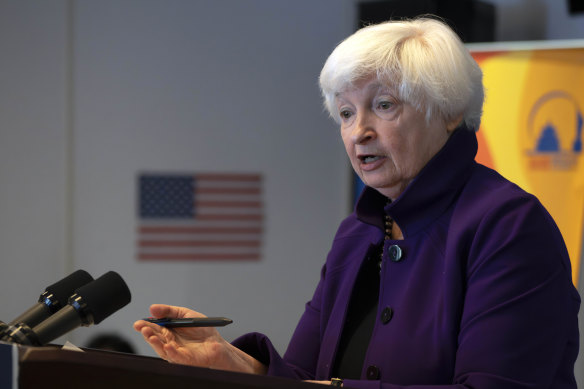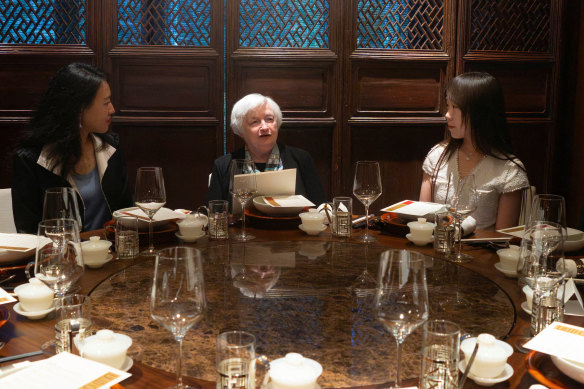
Save articles for later
Add articles to your saved list and come back to them any time.
Former president Bill Clinton once famously claimed to have smoked marijuana but swore that he didn’t inhale.
Now, US Treasury Secretary Janet Yellen is saying that yes, she ate mushrooms that might have had hallucinogenic properties – but (promise, Dad!) she didn’t actually get high from them.
America’s CFO was talking about a dinner she ate while attending high-profile meetings in Beijing last month, where one of the dishes was made with a mushroom known as jian shou qing.
Treasury Secretary Janet Yellen during a press conference at the US Embassy in Beijing.Credit: AP
After the dinner made a splash in China because a local food blogger reportedly posted about it on social media, Yellen was asked about her “mushroom experience” during an interview this week with CNN’s Erin Burnett.
“There was a delicious mushroom dish. I was not aware that these mushrooms had hallucinogenic properties,” Yellen said with a laugh, noting that she didn’t order the dish, but the person who arranged the outing did.
“I learned that later.” It was tasty, the former Fed said, but didn’t get her high.
US Treasury Secretary Janet Yellen speaks at a lunch meeting with women economists in Beijing in July.Credit: Reuters
That’s the way locals in the Yunnan province, where they are wild-foraged, typically see these mushrooms, says Colin Domnauer, a PhD candidate at the University of Utah, who has been studying them.
Domnauer notes that while Americans and other westerners might prize such a mushroom because of its psychedelic qualities, the locals value it for its flavour – which he describes as umami-laden and porcini-like, albeit a bit less nutty.
“There’s a difference in cultural attitude about the psychoactive effect – it’s like the food itself is more important than this property,” he says.
You can find the mushroom (actually a range of species, many of which are almost identical), whose name translates literally as “see hand blue” because its flesh bruises and turns blue when pressed, at markets and in restaurants in Yunnan, as well as other places that serve the province’s cuisine, such as the restaurant where Yellen and her party dined.
And although some people have reported experiencing “Lilliputian hallucinations” – meaning people who ingested it claimed to have had visions of small people – it can be rendered decidedly non-hallucinogenic by proper cooking.
Yellen said she had read that “if the mushrooms are cooked properly, which I’m sure they were at this very good restaurant, that they have no impact.”
And indeed, she said, “all of us enjoyed the mushrooms, the restaurant, and none of us felt any ill effects.”
Domnauer recently visited Yunnan to collect samples, and he, too, dined on the local delicacy at a hot pot restaurant. There, the staff set out a timer and instructed diners to cook the mushrooms in the boiling liquid for at least 15 minutes before eating it, he said, adding that nobody experienced any hallucinations.
While the mushroom in question is widely considered to be delicious, it also contains mysteries that mycologists are trying to unlock.
Here’s what makes these fungi so interesting: Scientists have yet to identify the compound in them that accounts for their psychoactive effects, notes Matthew Kasson, a mycologist and professor at the University of West Virginia’s Davis College.
Analysis has not turned up psilocybin, which is the stuff commonly found in most “magic mushrooms” that makes them a popular recreational drug.
Nor did scientists find another such known compound, ibotenic acid, which appears in those red-and-white polka-dotted mushrooms sometimes referred to as “Super Mario” mushrooms because of their depiction in the popular video game.
So what could explain those Lilliputian apparitions?
Maybe something entirely novel, Domnauer says, possibly a compound that could have exciting uses in medicine or other applications. He likened it to when mycologists first learned about psilocybin, which is now used in various psychiatric treatments, in the 1950s after studying the mushrooms used in ancient ceremonies in northern Mexico.
“There was a time when no one outside this small group in Oaxaca knew about it, and now it’s spread all over,” he says.
After Yellen’s meal, the jian shou qing dish is reportedly selling like hot cakes at various branches of the restaurant where she dined, whose name translates to “In and Out” (though it is, obviously, not affiliated with the American burger chain).
And while it might seem strange that a mushroom with the potential to make a diner see visions of tiny humans is a commonly consumed food, Kasson says that can be explained by differences in attitudes toward fungi more generally.
“That’s not a surprise to me, because in the East, there’s a broader acceptance for fungal foraging, and there is a lot of respect for fungi in Eastern culture in both food and medicine,” he says.
Westerners, on the other hand, “tend to vilify fungi – they’re associated with decay, they’re associated with death, or we think they’re going to kill us.”
Washington Post
Get a note directly from our foreign correspondents on what’s making headlines around the world. Sign up for the weekly What in the World newsletter here.
Most Viewed in World
From our partners
Source: Read Full Article

